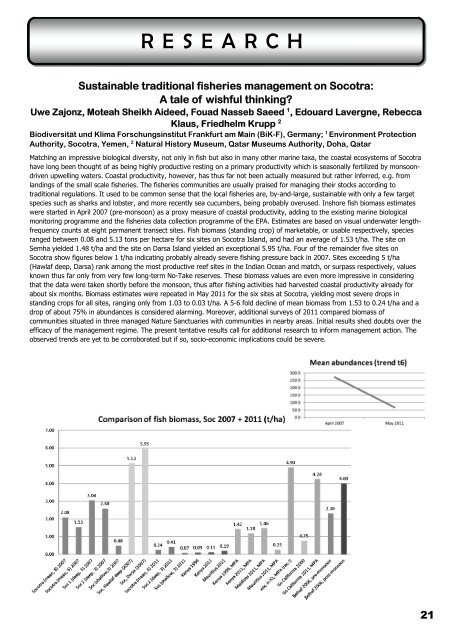TAYF the Soqotra Newsletter - Friends of Soqotra
TAYF the Soqotra Newsletter - Friends of Soqotra
TAYF the Soqotra Newsletter - Friends of Soqotra
Create successful ePaper yourself
Turn your PDF publications into a flip-book with our unique Google optimized e-Paper software.
RESEARCH<br />
Sustainable traditional fisheries management on Socotra:<br />
A tale <strong>of</strong> wishful thinking?<br />
Uwe Zajonz, Moteah Sheikh Aideed, Fouad Nasseb Saeed 1 , Edouard Lavergne, Rebecca<br />
Klaus, Friedhelm Krupp 2<br />
Biodiversität und Klima Forschungsinstitut Frankfurt am Main (BiK-F), Germany; 1 Environment Protection<br />
Authority, Socotra, Yemen, 2 Natural History Museum, Qatar Museums Authority, Doha, Qatar<br />
Matching an impressive biological diversity, not only in fish but also in many o<strong>the</strong>r marine taxa, <strong>the</strong> coastal ecosystems <strong>of</strong> Socotra<br />
have long been thought <strong>of</strong> as being highly productive resting on a primary productivity which is seasonally fertilized by monsoondriven<br />
upwelling waters. Coastal productivity, however, has thus far not been actually measured but ra<strong>the</strong>r inferred, e.g. from<br />
landings <strong>of</strong> <strong>the</strong> small scale fisheries. The fisheries communities are usually praised for managing <strong>the</strong>ir stocks according to<br />
traditional regulations. It used to be common sense that <strong>the</strong> local fisheries are, by-and-large, sustainable with only a few target<br />
species such as sharks and lobster, and more recently sea cucumbers, being probably overused. Inshore fish biomass estimates<br />
were started in April 2007 (pre-monsoon) as a proxy measure <strong>of</strong> coastal productivity, adding to <strong>the</strong> existing marine biological<br />
monitoring programme and <strong>the</strong> fisheries data collection programme <strong>of</strong> <strong>the</strong> EPA. Estimates are based on visual underwater lengthfrequency<br />
counts at eight permanent transect sites. Fish biomass (standing crop) <strong>of</strong> marketable, or usable respectively, species<br />
ranged between 0.08 and 5.13 tons per hectare for six sites on Socotra Island, and had an average <strong>of</strong> 1.53 t/ha. The site on<br />
Semha yielded 1.48 t/ha and <strong>the</strong> site on Darsa Island yielded an exceptional 5.95 t/ha. Four <strong>of</strong> <strong>the</strong> remainder five sites on<br />
Socotra show figures below 1 t/ha indicating probably already severe fishing pressure back in 2007. Sites exceeding 5 t/ha<br />
(Hawlaf deep, Darsa) rank among <strong>the</strong> most productive reef sites in <strong>the</strong> Indian Ocean and match, or surpass respectively, values<br />
known thus far only from very few long-term No-Take reserves. These biomass values are even more impressive in considering<br />
that <strong>the</strong> data were taken shortly before <strong>the</strong> monsoon, thus after fishing activities had harvested coastal productivity already for<br />
about six months. Biomass estimates were repeated in May 2011 for <strong>the</strong> six sites at Socotra, yielding most severe drops in<br />
standing crops for all sites, ranging only from 1.03 to 0.03 t/ha. A 5-6 fold decline <strong>of</strong> mean biomass from 1.53 to 0.24 t/ha and a<br />
drop <strong>of</strong> about 75% in abundances is considered alarming. Moreover, additional surveys <strong>of</strong> 2011 compared biomass <strong>of</strong><br />
communities situated in three managed Nature Sanctuaries with communities in nearby areas. Initial results shed doubts over <strong>the</strong><br />
efficacy <strong>of</strong> <strong>the</strong> management regime. The present tentative results call for additional research to inform management action. The<br />
observed trends are yet to be corroborated but if so, socio-economic implications could be severe.<br />
21


